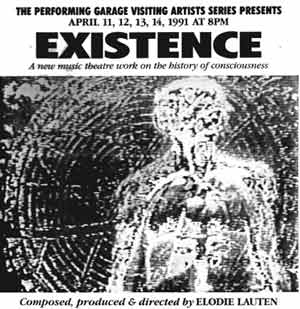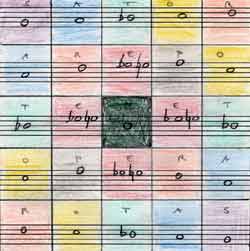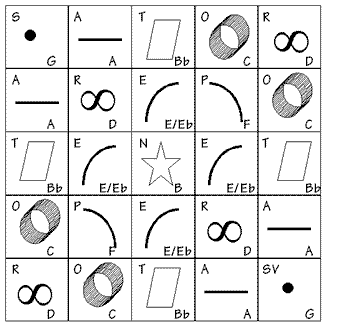ELODIE LAUTEN
Existence

Still from the video animation
Composed,
produced and directed by Elodie Lauten, video animation by Lauten.
Instrumentation: tenor, soprano, mezzo soprano, narrator, piano, synth,
percussion.
Premiere: Performing Garage, 1991
Existence is a opera of consciousness rooted in Africa, a meditation on the dialectic between man and the universe, inspired by the new developments of cosmology. Even though scientific theories are getting closer to explaining the dynamics of the universe, there still is a zone of mystery that metaphysicians and philosophers of all times have tried to explore. Quantum physics show the amazing range of realities from the infinitely small scale of the atom to the infinitely large scale of the expanding universe. Looking back at Pascal's Pensees on the two infinities, it is remarkable how similar the analysis of the 17th century philosopher and the new scientific theories are. On the other hand, the 'Schroedinger's cat' experiment uses the paradigm of an imaginary cat placed in a closed box where a vial of poison gas can be released at any moment. Is the cat alive or dead? He is neither, until the fact can be observed. There is actually no way of establishing the existence of anything outside the presence of the observer. Man is the creator of the so-called outside world, both subject and object of a simultaneous, multidimensional reality. This is reflected in the process of mental activity, constantly weaving patterns from different levels of thoughts and harmonizing them as they proceed in time, as would a musical score.
This transparency of consciousness, and its evolution since the beginning of time is the theme of the piece. The different scenes focus on key moments or key thoughts: the big bang, the planting of the first seed by a woman in Africa, the awareness of spatial relationships and the heritage of Pythagoras, the Eastern mind's contemplative wisdom, the alteration of reality by the alchemist, the influence of women, and finally, the essence of form in the geometry of point, line, plane and volume.
In the video, each image is individually sampled on to computer from a slide, drawing or collage, then grouped together with other samples to form a sequence which is processed via custom-designed software. The video was produced in collaboration with Nick Didkovsky who provided a video animation software. The images were created or otherwise produced by Lauten, and so was the editing and final product. The project received two video residencies, one at Film Video Arts (NYC) and the other at the Experimental Television Center, Owego, NY.
Existence had a 4-night run at Performing Garage in the spring of 1991. It included a video installation, stage set by Carl Karas, soprano Mary Hurlbut, mezzo Jesteena Walters, Frank Haye, tenor, two percussionists (including Mustafa Ahmed), and the composer on piano and analog synthesizer. It was well-attended and well received.
The key to understanding the Existence score is the SolarSys Matrix. It is based on a planet-scale scheme, connecting the different planets with certain scales, taking the musical scale as a direct expression of universal order. At the root of this idea is the work of Pythagoras, who was the first known to establish a parallel between the spatial relationships and the intervals contained in the scale.
"The
Pythagorean scale is an unconditioned, archetypal manifestation of cosmic
principles. Number and proportions, as Pythagoras understood, operate
in that realm, man needs to develop a mind that has basically freed itself
from bondage to biological energies and mythic-cultural specialization
and exclusivism. When conceived by the archetypal mind, music can become,
at least potentially, a universal, supercultural language."
Dane Rudhyar, The Magic of Tone and the Art of Music.
There are a number of planet-scale schemes (see examples). One common element is the desire to find a true relationship between music and our perception of outer space, whether the schemes seem arbitrary, intuitive or actually scientific. For the purpose of ordering a piece with this type of hierarchy, I used a G minor natural scale to start for Earth, Moon, Venus, Mars Mercury, Jupiter and Saturn. For the more remote planets, Uranus, Neptune and Pluto, I used a series of pitches that were not part of the original G minor natural scale – therefore opening a door to chromaticity and dissonance.

Each note is matched to a planet and syllable to create a 'solfege' based on phonemes common to many languages. This is used in some instances in lieu of lyrics.
The final section of Existence, The Four Stages of Manfestation: Point, Line, Plane and Volume, is based on the Palindromatrix, using multiple symmetries.
Original palindrome
|
s
|
a
|
t
|
o
|
r
|
|
a
|
r
|
e
|
p
|
o
|
|
t
|
e
|
n
|
e
|
t
|
|
o
|
p
|
e
|
r
|
a
|
|
r
|
o
|
t
|
a
|
s
|
Plaindromatrix: each letter of the palindrome is matched with a pitch

Shown visually

Copyright Elodie Lauten 2005